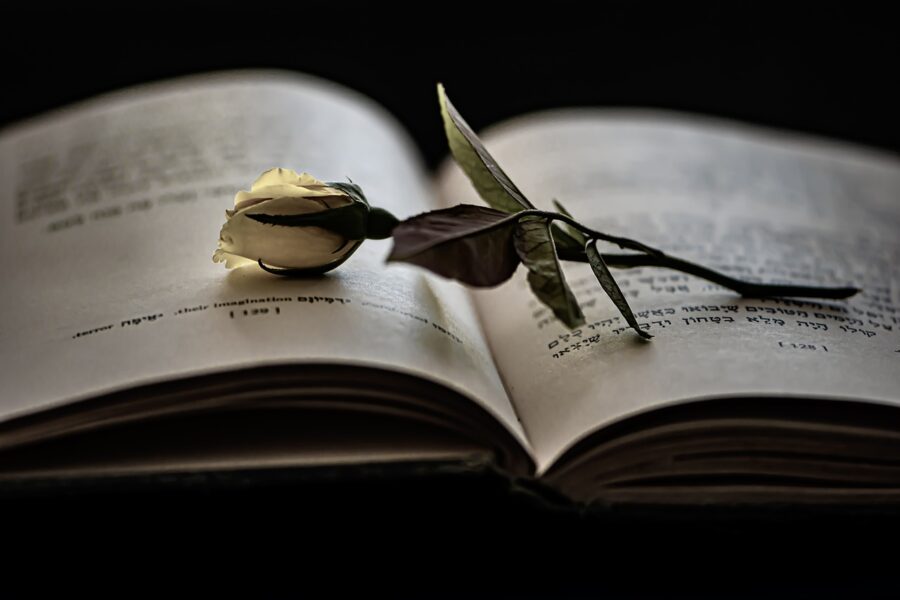
Though the modern love novel’s roots can be traced to around the 18th or 19th century, love and art have coexisted for far longer. Ancient Greek romances (such as Chariton’s Callirhoe) influenced the genre of romance, developed in the mid-12th century in French aristocratic courts. This takes us to the present day, where GoodReads ranks its most-read romance this week (w/c 5th February) as Sarah J. Maas’ House of Flame and Shadow – a new adult fantasy book.
Ancient Greece
Love in Ancient Greece was vast, to say the least. Their different types of love (Eros, Ludus, Philautia, Mania, Pragma, Storge, Philia and Agape) are concepts still widely used in Western culture today. Born c. 610 BCE, Greek lyric poet Sappho used art as a medium to express love. Her (perhaps most famous) poem Ode to Aphrodite pleas to Aphrodite, the goddess of love, regarding her love for an unnamed woman. Despite being written circa the 6th century BCE, the lexicon of emotion she uses remains relevant to the modern reader. In her essay, Rachel Rebecca Tatro Duarte writes that “Sappho’s influence is vast and yet largely invisible. Who doesn’t appreciate that love is ‘bittersweet,’ but so few people know that this is Sappho’s construction”.
Medieval Love
In the Middle Ages, a common literary trope was courtly love or ‘amour courtois’ and people often did not marry for love. Any English undergraduate will be familiar with Sir Gawain and the Green Knight or the Lais of Marie de France. In the latter text, the love stories often have a moral behind them. These texts often also, influenced by society, involved religious piety. At first glance, these may not seem relevant to today’s society at all, yet the concept of love as something to win over clearly links to the attainable aspect of courtly love. The codes of chivalry claimed ‘He who is not jealous cannot love’: a theme running through the later Othello and Wuthering Heights.
Love in the Victorian novel
The Victorian period produced some of the most influential writers. One of these is Jane Austen, whose consciousness of love is evident in her romantic novels. They often explore marriage, though the novelist herself famously never married. Another form of romance in this period is destructive, forbidden, often homoerotic love: take Oscar Wilde’s The Picture of Dorian Gray, or Sheridan Le Fanu’s Carmilla. The latter is a vampire horror predating Dracula. The story is told through the perspective of a young woman, practically haunted by the eponymous Carmilla, a vampire who desires her. Carmilla’s love is portrayed, like that written by Emily Brontë, as destructive and all-consuming: “You will think me cruel, very selfish, but love is always selfish; the more ardent the more selfish. How jealous I am you cannot know. You must come with me, loving me, to death; or else hate me, and still come with me, and hating me through death and after. There is no such word as indifference in my apathetic nature”. For the likes of Austen, writing about marriage perhaps intertwines with the society its novels were written in. As Ayda Loewen-Clarke puts it, “the evolution of the family unit led to a heightened societal value for marriages based on mutual affection, emotional satisfaction, and love”. She continues, talking about Victorian same-sex marriages, “the evolution of marriage laws allowed a certain amount of flexibility that allowed female couples living together to use the language of marriage to describe their relationships as well”. The power of the language of marriage is important: love and language will forever be connected. In the case of Carmilla, it is still evident that the novel has a long way to go for positive representation, and its language certainly contributes to this.
The Modernist and Love
Perhaps one of the biggest landmarks of this period is James Joyce’s Ulysses, which claims “love loves to love love”. This period also birthed a disillusioned love, one which F. Scott Fitzgerald looks at. Using this disillusionment to mimic the American Dream, the novelist ultimately describes the fall of a dream that never existed: the eponymous Jay Gatsby’s love, or the American Dream. Thus, rather than the attitude to love intertwining with society, The Great Gatsby uses love as a metaphor for attitudes in society. Yet in Virginia Woolf’s Mrs Dalloway, love and society are as in touch with each other as ever. The title character’s reflection on her different loves showcases a diverse range of romance and attitudes; the novel explores marital romance, same-sex romance and unrequited love. In the 20th century, romantic love shifted massively. New values and attitudes emerged, yet the idea of an eternal or enduring love remained: a universal theme in these novels. Mark Manson writes “Romance is an easy sell. We all enjoy seeing the hero get the girl. We enjoy seeing the happy ending. We enjoy believing in “happily ever after.” It feels good. And so the commercial forces that arose in the 20th century took it and ran with it”. Media consumption and language also shape values towards love.
Across time, the unifying force between these texts is romance: something the reader will relate to, but the texts as well with each other. It manages to never disappear from the eye of the reader, as a literary trope but also in cinema, media and embedded in the daily life of an individual. Despite their evolution, romance and literature are as inseparable as lovers themselves.


